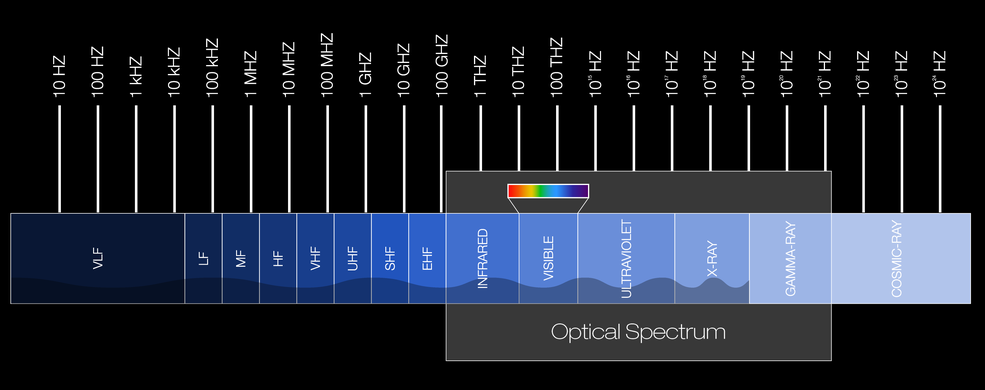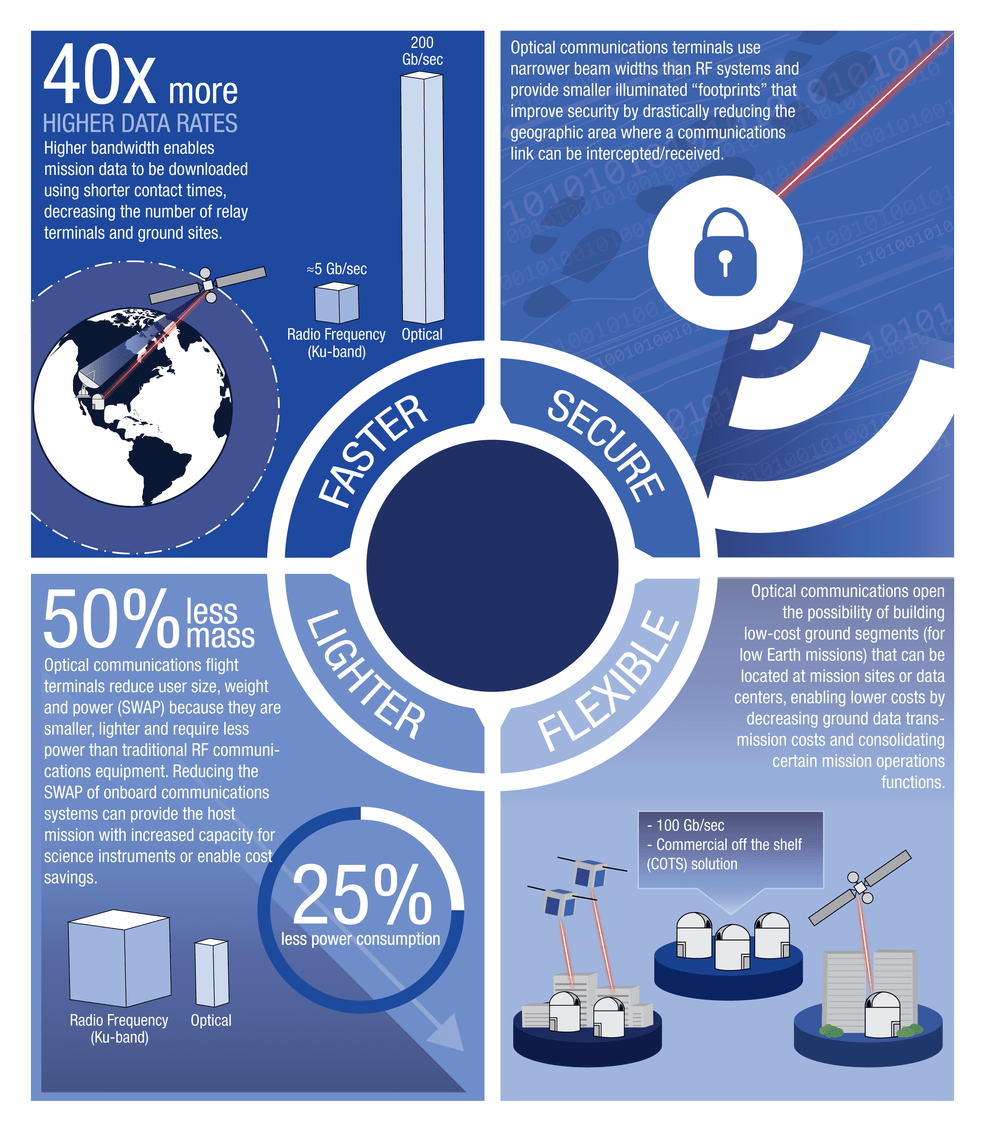Overview
As NASA missions become increasingly more sophisticated, the amount of data they are able to gather and transmit to Earth is rapidly rising. To accommodate this need, NASA has transitioned to higher-bandwidth radio spectrum usage. However, there is no way for NASA to use radio frequency communications to carry higher data rates without increasing the size of its antennas or power of its radio transmitters. Therefore, NASA is developing optical communications to address limitations of radio frequency (RF) communications, including: bandwidth, spectrum and overall size of frequency packages and power used.
Optical spectrum uses light as a means of transmitting information via lasers.
Optical communications benefits include being faster, more secure, lighter and more flexible.
Optical communications challenges include a need for precise laser beam accuracy and Earth’s atmosphere interference, such as clouds.
Optical communications timelines are outlined in both a technology and demonstration timeline through 2023, as well as an operational timeline through 2026.
Optical Spectrum
Optical communications use light as a means of transmitting information over long distances. Within the context of NASA, optical communications technology sends data across space using lasers instead of radio frequencies.
Space Communications and Navigation (SCaN) will use optical transceivers both on the ground and in space to send and receive information. The transceivers will be able to utilize many of the composite portions of the optical spectrum through the implementation of signal modulation.
Currently, optical spectrum is note regulated, however, SCaN collaborates with international working groups on the use of optical spectrum.
Benefits
- Faster: Higher data rates can enable increased data volume for missions that have been able to generate far more data than they could downlink, or enable new “high definition” instruments that collect larger volumes of data. It’s not that the data is traveling faster with optical communications compared to radio communications. Instead, higher data rate links will enable mission data to be downloaded using shorter contact times, resulting in the use of less onboard spacecraft power and requiring fewer relay terminals and ground sites to support missions. Therefore, the process is sped up.
- Secure: Optical communications terminals use narrower beam widths than radio frequency (RF) systems. They provide smaller illuminated “footprints” that improve security by drastically reducing the geographic area where a communications link can be intercepted/received.
- Lighter: Optical communications flight terminals reduce user Size, Weight, and Power (SWAP) because they are smaller, lighter and require less power than traditional RF communications equipment. Reducing the SWAP of onboard communications systems can provide the host mission with increased capacity for science instruments or enable cost savings.
- Flexible: Optical communications open the possibility of building low-cost ground segments (for low Earth missions) that can be located at mission sites or data centers, enabling lower costs by decreasing ground data transmission costs and consolidating certain mission operations functions.
Challenges
For all its benefits, optical communications still faces several challenges. Unlike radio communications, which can be sent out in a broad beam blanketing target areas with its signal, optical communications is sent in a relatively narrow beam pointed directly at a receiver. When broadcasting from thousands or millions of miles away, an optical communications telescope pointing must be extremely precise. A deviation of even a fraction of a degree can result in the laser missing its target entirely.
To enhance the optical communications beacon-aided acquisition, Space Communications and Navigation (SCaN) is developing beacons near the receivers onto which spacecraft can lock-on to. Just like terrestrial lasers, the beam of space based optical lasers spreads out, or becomes dispersed. As this occurs, the light becomes less dense and the data is harder to retrieve. Special receivers called photon counting detectors are being developed to detect single photons as they travel in the optical beam from space to earth.
Even Earth’s atmosphere interferes with optical communications. Clouds and mist can interrupt a laser. A solution to this is building multiple ground stations, which are telescopes on Earth that receive infrared waves. If it’s cloudy at one station, the waves can be redirected to a different ground station. With more ground stations, the network can be more flexible during bad weather. SCaN is also investigating multiple approaches, like Delay/Disruption Tolerant Networking and satellite arrays to help deal with challenges derived from atmospheric means.
Timeline
- 2021-2023: Near Earth Relay Technologies
- Laser Communications Relay Demonstration (LCRD) Optical Relay Demo (2021)
- 1.244 Gbps optical relay two ground stations
- Routing of optical signals in a hybrid environment (RF/optical)
- Launched December 7, 2021
- Integrated LCRD Low-Earth Orbit User Modem and Amplifier Terminal (ILLUMA-T) User Relay (2023)
- 1.244 Gbps user terminal
- LEO satellite acquisition and tracking in a GEO relay system- (LCRD)
- Space Station <==> LCRD <==> Earth
- NET January 2023
- Laser Communications Relay Demonstration (LCRD) Optical Relay Demo (2021)
- 2022: Near Earth Direct to Earth (DTE) Technologies
- TeraByte InfraRed Delivery (TBIRD): 200 Gbps Demo (2022)
- 100 Gbps user terminal; 100 Gbps low-cost ground station
- Space technologies based on commercial off the shelf (COTS) products
- CubeSat-sized, low size, weight and power (SWAP) user terminal, user-site installable ground station
- Launched May 25, 2022
- TeraByte InfraRed Delivery (TBIRD): 200 Gbps Demo (2022)
- 2022: Deep Space DTE Technologies
- Discovery Psyche Demo
- Space user terminal 125 Mbps at 40 Mkm range
- 5-meter optical ground station
- Deep space optical link
- Discovery Psyche Demo
Operational Timeline
- 2021: LCRD: Geosynchronous Earth Orbit (GEO) Relay Technology Demonstration
- 2022: TBIRD: 200 Gbps Low Earth Orbit (LEO) Direct to Earth (DTE) Near Earth Demonstration
- 2022: Psyche: Deep Space Technology Demonstration
- 2023: ILLUMA-T: User Relay Technology Demonstration





























